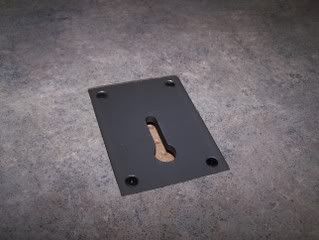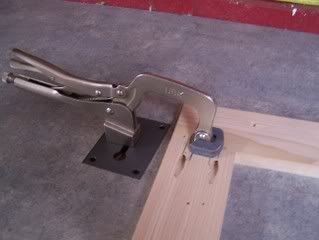Inlay practice and a very useful gadget…
This weekend was all about wrapping up some shop chores. I have several projects for the shop that need to get done before I embark on the Roubo bench project. First and foremost is a dedicate sharpening station. Right now my Tormek, stones, files, etc are kept in a wall cabinet. I have to lug them out everytime I need to freshen an edge. It probably goes without saying that because of that extra step I sometimes wait too long to sharpen and spend more time that I should working with dull tools. So I drew up a list of what I would need to store, how I wanted it organized, and then sketched out a simple cabinet on wheels design to meet those needs.
My philosophy on shop furniture varies depending on how anxious I am to get on to my next project. Most of the time I use these shop projects as a practice session to try out new techniques. My drill press cart that was completely recently was one example:
Here I cut all the tongue and groove joinery for the frame and panels using just a saw and shoulder plane. I cut all the panel grooves using a plow plane, and I hand cut the dovetails that connect the top stretchers to the carcass. It was a fun learning experience and only used scraps that were laying around the shop. In the instance of this sharpening station, I really want to bang it out and move on some other projects. So I decided to built the whole thing using frame and panel again to make use of some 2x construction lumber I have left over from an earlier demolition; however, this time I will use pocket holes for the joinery.
I have the Kreg master kit and I find it to be a great tool. When I first bought it about a year ago, the Woodcraft where I got it was having a special that got me the Bench Klamp system for 50% off when you buy the Master kit. Up until now I haven’t done anything with that bench clamp. Recently I ripped out my old countertops and put in laminate covered MDF for more weight and stability. Now that these are in, I decided it would be good to install the clamping plate. The added bonus being that with all the pocket holes in my sharpening station the assembly will be much faster.
(Are you starting to see where the woodworking A-D-D theme of this site comes from???)
So I built a frame that perfectly fits around the clamp plate and double stick taped the frame down to the countertop where I wanted to install the plate. Using a trim router, I hogged out the laminate and MDF to match the thickness of the plate. Then I used a forstner bit to hollow out the center of the inlay to allow for the bolt that the clamp travels on just like keyhole hanging hardware. Next I had to square up the rounded corners. Normally this is a simple process with a chisel but the added difficulty of laminate made things a little more interesting. That stuff is slick and tough, but eventually I was able to get through it and cleaned up the corners. I fitted the plate and coaxed it into place with a mallet and the fit was great all around the edges. It was a little shallow at the top so I pulled the plate back out and hit the inlay with my router plane to remove that little bit of extra material. Now the plate fits snugly and flush with the counter. I installed the four wood screws at the corners and the clamp was ready to go!
Here it is with the clamp in place.
Finally I put it to the test. Normally when driving the pocket screws, Kreg supplies you with a clamp but you have to have the room to get the clamp under the workpiece and it makes it dicey to line up the pieces and keep them flush. In this instance, I was able to align my rail and stile perfectly and just drop the clamp and was ready to drive the screws.
This will save me a huge amount of time and I can already see other areas where this handy clamp will be very useful. Maybe I’ll buy one or two more now and sit on those for a year before installing them!






